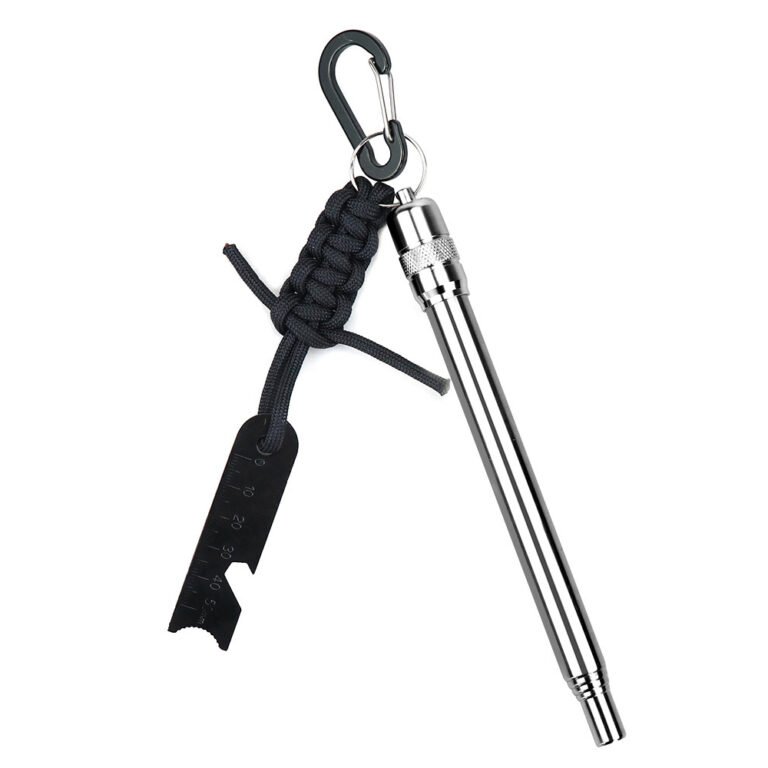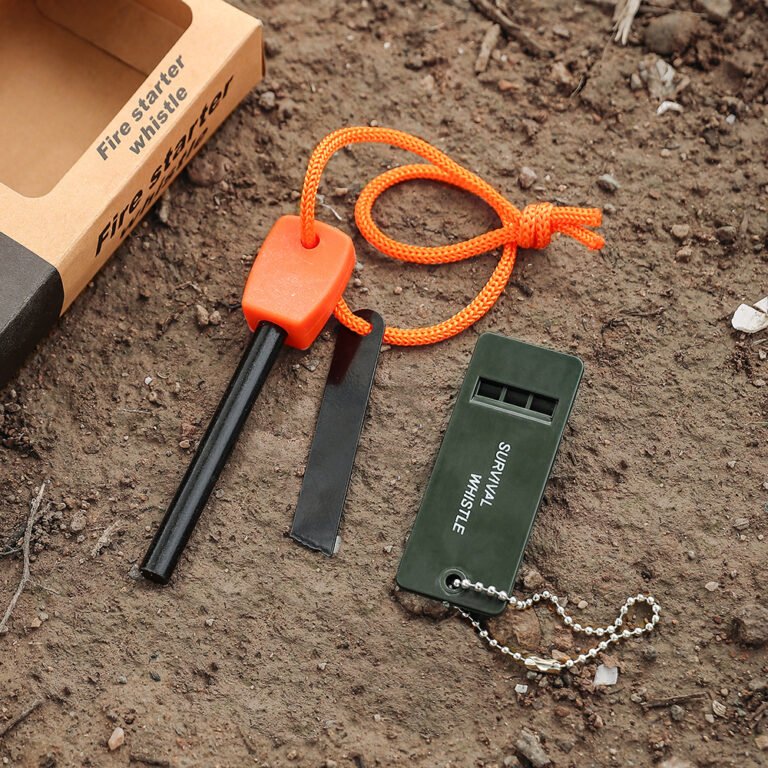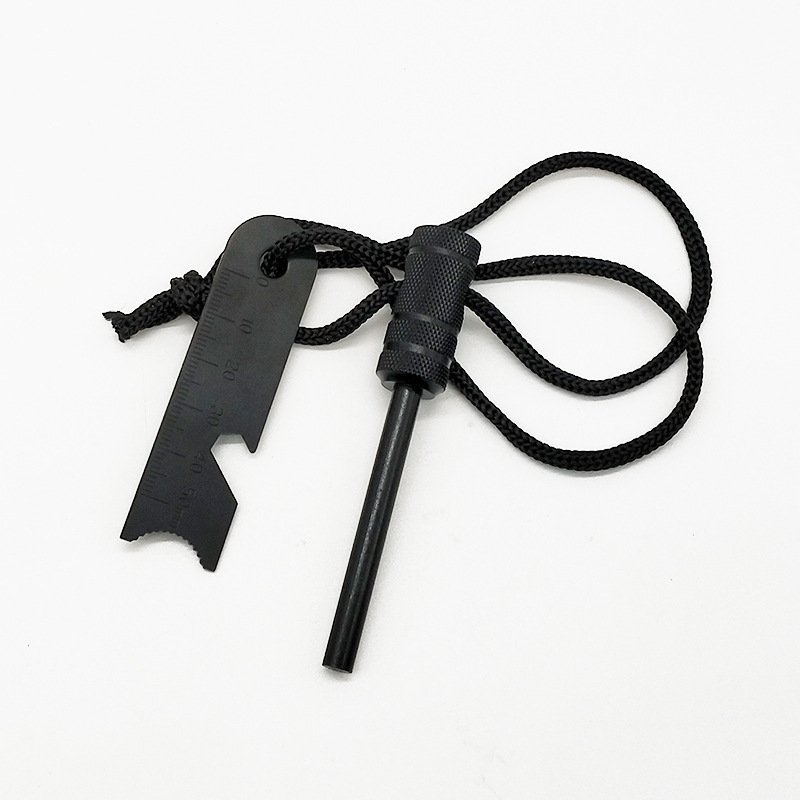
Why Use a Ferro Rod?
Imagine you’re out in the woods. It’s cold, getting dark, and you need a fire. You grab your matches—but they’re wet. Your lighter? Out of fuel. Now what?
This is where a ferro rod comes to the rescue.
A ferro rod, short for ferrocerium rod, is a special kind of fire starter. It’s small, tough, and throws super-hot sparks that can light a fire almost anywhere—even in the rain or snow. That’s why campers, hikers, and survival experts love it.
In this guide, we’ll show you what a ferro rod is, how it works, and why it might be the most important tool in your backpack. Whether you’re building a campfire, planning for emergencies, or just want to learn something cool, you’re in the right place.
Let’s strike up some sparks and dive in.
What is a Ferro Rod, Really?
If you’ve never heard of a ferro rod, don’t worry—you’re not alone. Let’s break it down in the simplest way.
A Tiny Stick That Makes Big Sparks
A ferro rod (short for ferrocerium rod) is a small stick made from a special metal mix. When you scrape it with something hard—like a piece of steel—it throws off hot sparks. And we mean really hot: around 3,000°C (5,400°F). That’s hot enough to light dry grass, wood shavings, or even cotton balls on fire!
What Is It Made Of?
A ferro rod is made from a blend of metals. The main one is called cerium, but it also has other metals like iron and magnesium. When you scrape it quickly with a sharp edge, tiny bits of the rod break off and catch fire in the air. That’s what makes the sparks.
The full name for this tool is ferrocerium rod, but most people just say “ferro rod” or even “fire steel.”
What Does a Ferro Rod Look Like?
It looks pretty simple:
- It’s a short, round rod—usually black or dark gray.
- It’s often attached to a handle made of wood, plastic, or paracord.
- It usually comes with a scraper or striker, a small piece of metal you use to scrape the rod.
Some people even carry mini ferro rods on their keychains. Others pack bigger ones for camping and survival kits.
How Is It Different from Flint and Steel?
You might’ve seen old movies where people bang rocks together to make fire. That’s called flint and steel. A ferro rod works in a similar way, but it’s much easier to use and creates a lot more sparks. It’s like the upgrade version for modern adventurers.
Why Choose a Ferro Rod Over Matches or Lighters?
Let’s be honest—matches and lighters are super easy to use. You strike a match or flick a lighter, and boom, fire! So why would anyone use a ferro rod instead?
Good question. Let’s break it down.
1. Matches Can Get Wet… and Then They’re Useless
Imagine you’re camping and it starts to rain. You reach into your bag for your box of matches, but they’re wet. Uh-oh. Now you can’t start a fire.
But a ferro rod still works—even if it’s raining or snowing! The sparks it makes are super hot, so they can light up even slightly damp tinder. That’s a big win.
Ferro rod = works in all weather.
2. Lighters Run Out of Fuel
Lighters are handy. But have you ever picked one up, flicked it, and nothing happened? That’s because it ran out of fuel or the lighter fluid dried up.
A ferro rod doesn’t need any fuel. No gas. No refill. No batteries. You can use it again and again—some can last for thousands of strikes. That means one ferro rod could light hundreds of fires.
Ferro rod = no fuel, no problem.
3. It’s Strong and Long-Lasting
Drop a plastic lighter on a rock, and it might crack. Matches can bend or snap. But a ferro rod? It’s made from metal. It’s strong and tough, perfect for the outdoors.
Even better, a ferro rod can last for a very long time—sometimes up to 12,000 strikes (that’s a LOT of campfires).
Ferro rod = built to last.
4. It Works at High Altitudes and in the Cold
Did you know lighters sometimes stop working in really cold places or high up in the mountains? That’s because they rely on pressure and fuel.
A ferro rod doesn’t care how cold it is. Cold weather, no problem. Thin air, no problem. It just sparks.
Ferro rod = reliable anywhere.
5. It Teaches Real Survival Skills
Here’s something cool: using a ferro rod is a skill. It takes a little practice, but it’s super fun to learn. Once you get it, you feel like a real adventurer. Whether you’re building a fire in the woods or just in your backyard, it feels awesome.
It’s also a great way to learn patience, problem-solving, and how to survive without modern tools.
Ferro rod = learn real survival skills.
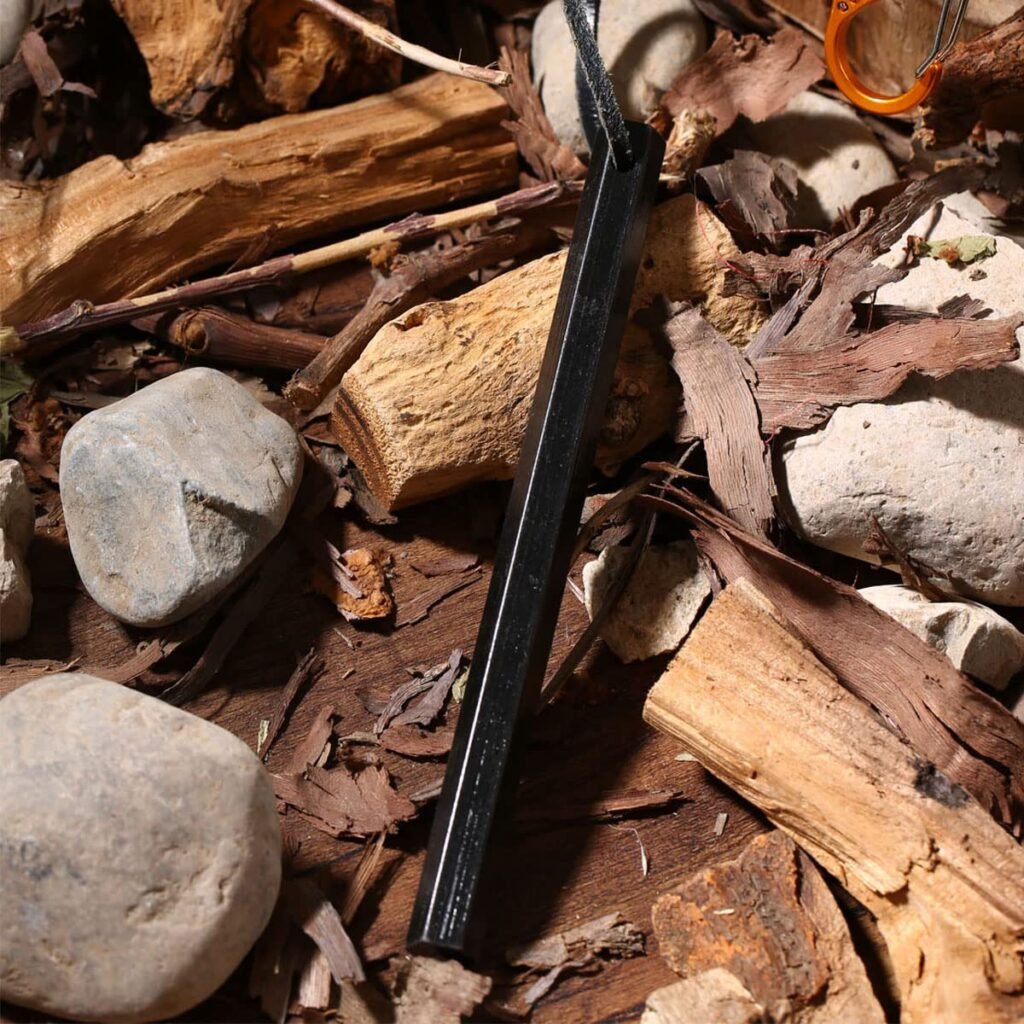
Anatomy of a Ferro Rod Fire Starter
What’s really inside this spark-making stick?
At first glance, a ferro rod fire starter looks pretty simple. It’s just a stick with something hanging off it, right?
Not quite.
A ferro rod may look small, but it’s made of some tough, fire-starting magic. Let’s take a closer look at what it’s made of, how each part works, and why it’s designed that way.
1. The Rod (The Spark Maker)
This is the main part of the tool—the ferro rod itself.
- It’s a stick made from a special metal mix called ferrocerium (ferro for short).
- When you scrape it with something hard and sharp, it throws out bright sparks.
- Those sparks are super hot—hot enough to start a fire.
Ferro rods come in different sizes:
- Small ones for keychains or backpacks
- Medium ones for camping
- Big, chunky ones for survival kits
Fun Tip: A longer rod gives you more strikes and bigger sparks!
2. The Striker (The Scraper Tool)
Next to the rod, you’ll usually find a striker.
- It’s a small piece of metal, often flat with a sharp edge.
- You scrape it down the rod quickly to make sparks.
- It’s sometimes attached with a string so you don’t lose it.
If you ever lose the striker, don’t panic—you can also use the back of a knife (as long as it’s not the sharp edge) or any hard steel edge to make sparks.
What makes a good striker?
- It should be sharp, strong, and easy to grip.
3. The Handle (Hold On Tight!)
Many ferro rods come with a handle on one end. It helps you hold the rod steady while you scrape it.
Handles can be made from:
- Wood (for a classic look)
- Plastic (for lightweight use)
- Paracord wrap (for extra grip and survival use)
Some even have glow-in-the-dark or waterproof handles—pretty cool if you ask us.
4. The Cord (Keeps It All Together)
A small rope or paracord is often used to connect the rod and striker.
- It keeps both parts from getting lost.
- Paracord can also be used in emergencies to tie things, fix gear, or even build a shelter.
Pro tip: If your ferro rod has no cord, it’s a good idea to add one yourself. You’ll thank yourself later!
How to Use a Ferro Rod Like a Pro
Let’s learn how to turn sparks into fire!
So, you’ve got your ferro rod. You know what it is. You know what it’s made of.
Now it’s time for the fun part—learning how to use it.
Starting a fire with a ferro rod might seem tricky at first, but once you get the hang of it, it feels like magic. Let’s go step by step.
Step 1: Gather Your Fire-Starting Materials
Before you make sparks, you need something to catch them. This is called tinder—tiny, dry stuff that lights up fast.
Good tinder ideas:
- Dry grass
- Cotton balls (bonus: dip them in petroleum jelly for extra firepower)
- Wood shavings
- Dryer lint
- Thin bark from birch trees
- Paper or tissue
Then collect:
- Kindling: small sticks and twigs (helps grow the fire)
- Fuel wood: bigger sticks and logs (keeps the fire going)
Tip: Set up your fire before you start striking—fire needs to spread quickly once it starts.
Step 2: Set Your Ferro Rod Close to the Tinder
- Put your tinder on the ground or on a dry leaf or piece of bark.
- Place the ferro rod close to the tinder, with the tip pointing just above it.
- Hold it steady with one hand.
Step 3: Scrape the Rod to Create Sparks
- Hold your striker (or the back of a knife) in your other hand.
- Press it firmly on the rod at an angle.
- Scrape it fast and hard down the rod.
Try to aim the sparks right into the tinder. If the tinder is dry and fluffy enough, it will start to smoke and catch fire.
Tip: Don’t move the rod. Instead, move the striker—this keeps your tinder from getting knocked away.
Step 4: Blow Gently on the Ember
Once your tinder starts to glow or smoke, blow gently to give it oxygen.
Too soft = no help.
Too hard = you might blow it out!
As it lights up, add kindling on top—small twigs or thin sticks.
Then slowly add bigger sticks to build your campfire.
Step 5: Celebrate—You Made Fire!
You did it! With just a rod, a striker, and some dry tinder, you created fire without matches or a lighter.
That’s a real survival skill.
That’s fire mastery.

When and Where You’ll Need One (Use Cases)
Real moments when a ferro rod can save the day
You’ve learned how to use a ferro rod fire starter, and now you’re pretty much a fire-making pro.
But when would you actually need to use one?
Here’s the cool part: ferro rods are useful in all kinds of real-life adventures. Whether you’re camping in the woods, stuck in an emergency, or just having fun in your backyard, a ferro rod can be a big help.
Let’s look at some real situations where your ferro rod becomes the hero.
1. Camping Trips
You’re in the forest. The sun is going down. You need a fire to cook dinner or roast marshmallows. But your lighter won’t work, and your matches are soggy from your water bottle leaking.
Your ferro rod saves the night.
It works even if it’s cold, windy, or damp. All you need is dry tinder, and you’re ready to make a fire.
Perfect for:
- Campfire cooking
- Staying warm
- Making s’mores (yum!)
2. Backyard Survival Practice
You don’t have to go to the mountains to use a ferro rod. You can practice fire-starting right in your backyard!
Build a safe fire area (ask an adult first), gather dry leaves and twigs, and challenge yourself to make fire without matches.
It’s fun, it’s safe (with supervision), and it teaches real skills.
Perfect for:
- Learning survival skills
- Family camping nights at home
- Scout projects or outdoor lessons
3. Hiking or Backpacking Adventures
When you’re hiking, you want to carry light and smart. Ferro rods are small, weigh almost nothing, and can last for thousands of strikes.
If you ever get lost, need to boil water, or signal for help, a fire could save your life. That’s why many hikers carry a ferro rod as part of their gear.
Perfect for:
- Emergency fire-starting
- Ultralight gear setups
- Backcountry survival kits
4. Emergency Situations or Bug-Out Bags
Natural disasters happen—storms, blackouts, or getting stranded. If you ever find yourself in a survival situation, you need to stay warm, boil water, and cook food.
That’s why every emergency or “bug-out” bag should have a ferro rod in it. It’s reliable and long-lasting, even if you haven’t used it for years.
Perfect for:
- Home emergency kits
- Car survival bags
- Storm and disaster prep
5. Hunting, Fishing, and Bushcraft
Hunters and fishermen often spend hours—or even days—out in the wild. Fires keep you warm, dry wet clothes, and cook food.
Bushcrafters (people who practice wilderness survival skills) love ferro rods because they work in tough conditions.
Perfect for:
- Warming up after a cold morning hunt
- Cooking freshly caught fish
- Practicing outdoor survival skills
6. Snow Days and Winter Fun
Even in the snow, a ferro rod works. In fact, cold and wet weather is exactly where it shines. Try lighting a small fire in the snow during a winter camping trip or after sledding.
Perfect for:
- Snow shelters
- Melting snow for water
- Staying warm in freezing weather
7. Everyday Carry (EDC) and Keychain Tools
Some ferro rods are small enough to fit on a keychain. That means you can carry fire with you—just in case.
You may never need it, but it’s there when you do. Just like your house key or flashlight.
Perfect for:
- Everyday preparedness
- Unexpected situations
- Backup for your backup
How to Choose the Right Ferro Rod
Not all ferro rods are the same—so how do you pick the best one?
Ferro rods may all look kind of similar, but there are some big differences between them.
Some are small. Some are giant. Some come with cool extras. Others are basic and tough.
So how do you know which one is right for you?
Let’s break it down into simple pieces so you can choose the best ferro rod for your next outdoor adventure—or backyard fire test!
1. Size: Big or Small?
Ferro rods come in different sizes, and that makes a big difference.
Small ferro rods (under 3 inches):
- Easy to carry on a keychain
- Great for emergencies or backup
- But harder to hold and use
Medium ferro rods (4–5 inches):
- Good balance of size and ease
- Easier to grip and strike
- Great for hiking, camping, or home kits
Large ferro rods (6 inches or more):
- Create lots of big sparks
- Last a very long time
- Great for bushcraft, cold weather, and survival training
Tip: If you’re just starting out, go for a medium or large rod. They’re easier to practice with.
2. Thickness: Thin vs. Thick
Ferro rods also come in different thicknesses.
- Thin rods (1/4 inch or smaller):
Lightweight, but don’t last as long
Good for short trips or keychains - Thick rods (3/8 inch and up):
Stronger and longer-lasting
Make more sparks
Great for regular use or survival kits
The thicker the rod, the longer it lasts.
3. Handle: Get a Good Grip
The handle is where you hold the rod, and it matters more than you might think.
- Plastic handles are light and cheap
- Wooden handles feel solid and traditional
- Paracord-wrapped handles give you extra cord for emergencies
Choose a handle that feels comfortable in your hand and won’t slip when it’s cold or wet.
4. The Striker: Don’t Skip This!
Every ferro rod needs a striker—the metal piece that scrapes off sparks.
Some strikers are basic. Others come with extra features like:
- Ruler or measuring edge
- Hex wrenches
- Bottle opener
- Sharp, spark-throwing edge
You can also use the back of a knife, but many people prefer a separate striker so they don’t dull their blade.
Pro Tip: A good striker makes a HUGE difference. If the sparks are weak, it’s probably not your rod—it’s the striker.
5. Extras: Are They Useful?
Some ferro rods come with bonus tools. Cool? Yes. Necessary? Not always.
You might find:
- Whistles (good for safety)
- Mini compasses (hit or miss)
- Magnesium bars (help start fires faster)
- Waterproof carrying cases
Ask yourself:
Do I need these? Or do I just want a solid rod and striker that work every time?
Sometimes simple = better.
6. Hard vs. Soft Ferro Rods
Here’s something most people don’t know—not all ferro rods feel the same when you strike them.
- Soft rods:
Make lots of big, bright sparks
Wear out faster
Easier to use for beginners - Hard rods:
Last longer
Make fewer but hotter sparks
Take more practice
If you’re just learning, a slightly softer rod can help.
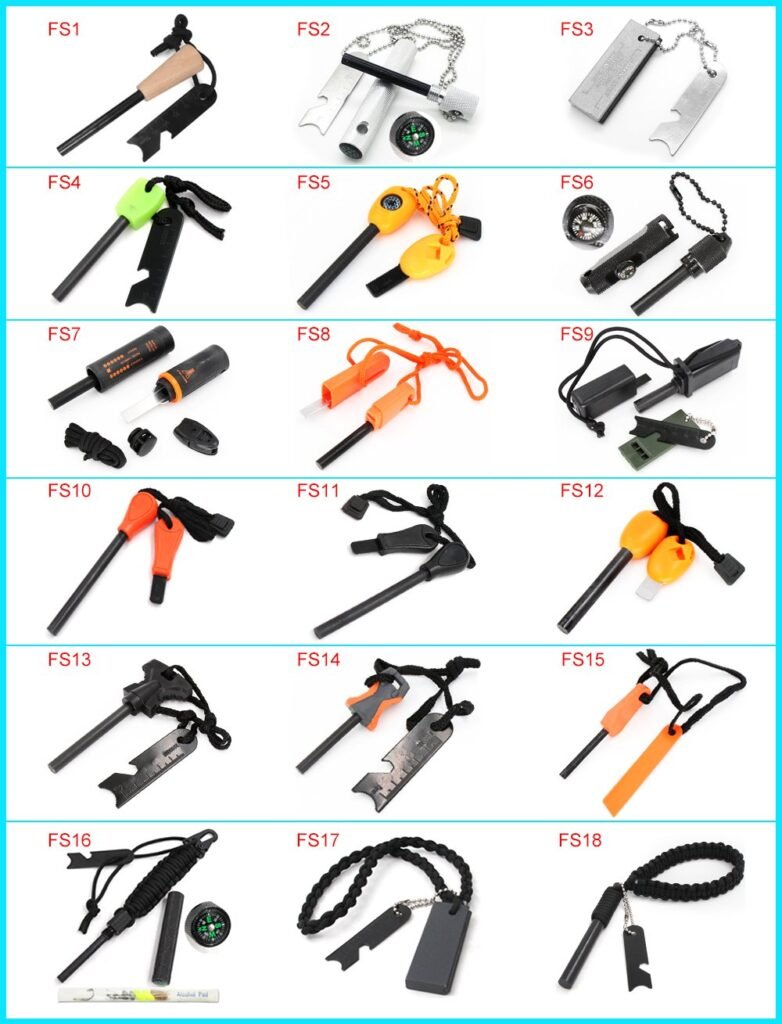
Conclusion
By now, you’ve probably figured it out—ferro rods are awesome.
They’re small, tough, and super useful. Whether you’re camping in the woods, practicing survival skills, or just roasting marshmallows in your backyard, a ferro rod can help you start a fire when nothing else will.
Here’s a quick reminder of why they’re so great:
- They work in rain, wind, and snow
- They don’t need fuel, batteries, or matches
- They last a long time—thousands of sparks
- They help you learn real-life outdoor skills
And best of all? They’re fun. Making fire with sparks feels like magic—and it’s a skill that can come in handy when you least expect it.
So if you’re putting together a camping bag, a survival kit, or just want to be more prepared, a ferro rod is a smart and simple tool to carry.
Give it a try. Practice with it. And the next time someone says, “Hey, how are we going to start this fire?”
You’ll be ready—with just a rod, a striker, and a spark.

